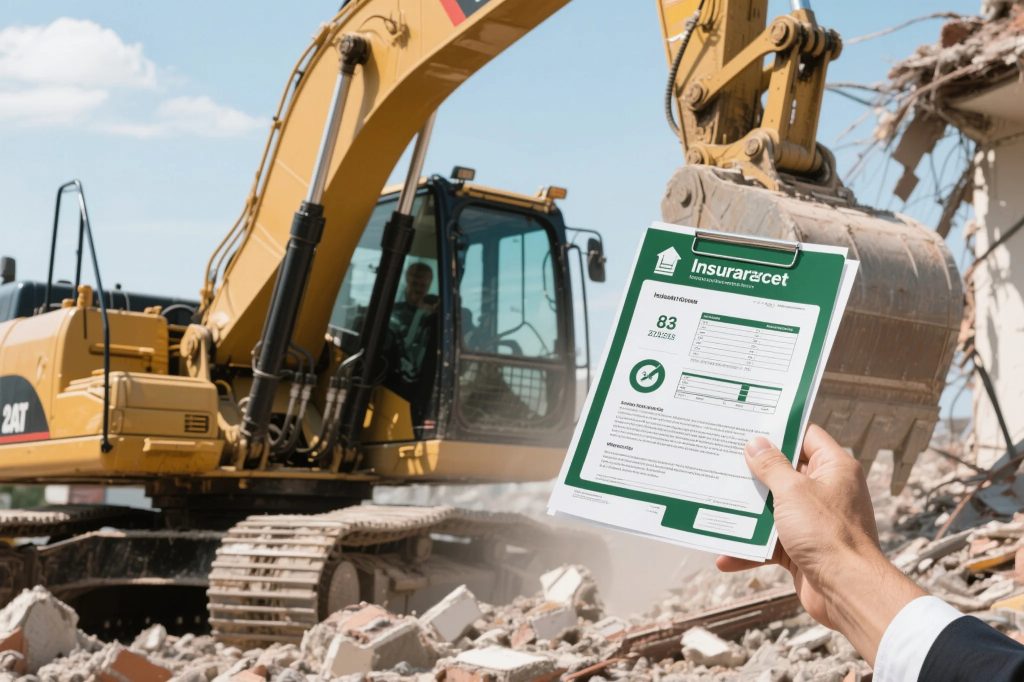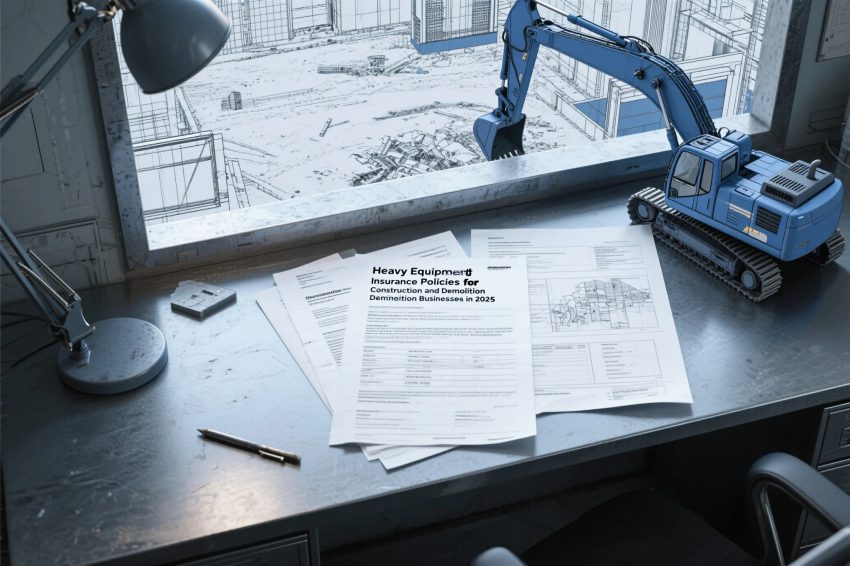Heavy Equipment Insurance Policies for Construction and Demolition Businesses in 2025
The Critical Role of Heavy Equipment Insurance in Modern Construction
The construction and demolition industries in the United States are undergoing a period of unprecedented growth and transformation. As infrastructure projects multiply and urban redevelopment accelerates, businesses in these sectors are relying more than ever on sophisticated heavy equipment to complete projects efficiently and safely. This increased reliance on expensive machinery brings with it significant financial risks that can threaten the viability of even the most established companies. Heavy equipment insurance has emerged as an essential safeguard, protecting businesses from the potentially devastating costs associated with equipment damage, theft, liability claims, and operational interruptions. In 2025, with equipment becoming more technologically advanced and expensive to repair or replace, having comprehensive insurance coverage isn’t just prudent—it’s a business necessity that can mean the difference between profitability and financial ruin.
Demolition Contractor Insurance: Specialized Protection for High-Risk Operations
Demolition work represents one of the most hazardous segments of the construction industry, with risks that extend far beyond typical construction activities. From controlled implosions to hazardous material abatement, demolition contractors face unique challenges that require specialized insurance solutions. Demolition contractor insurance in 2025 has evolved to address these specific risks, offering coverage for property damage, bodily injury, environmental liabilities, and even cyber threats to automated demolition systems. Modern policies now incorporate real-time monitoring capabilities that allow insurers to assess risk more accurately and provide dynamic pricing based on actual site conditions and safety practices. For demolition businesses, investing in robust contractor insurance isn’t just about meeting contractual requirements—it’s about demonstrating professionalism, protecting assets, and ensuring the ability to continue operations after unforeseen incidents.
Bridge Construction Insurance: Addressing the Unique Risks of Infrastructure Projects
Bridge construction presents a distinct set of challenges that standard construction insurance policies often fail to address adequately. The combination of working over water, dealing with complex engineering requirements, and managing heavy equipment in confined spaces creates a risk profile that demands specialized coverage. Bridge construction insurance in 2025 has become increasingly sophisticated, offering protection not just for the structure itself but also for the specialized equipment required for such projects. Policies now commonly include coverage for marine equipment, temporary works, professional liability for design errors, and even delay in completion costs. With infrastructure spending at historic highs and bridge projects becoming more ambitious, having tailored insurance coverage is essential for contractors bidding on these high-value, high-risk projects. The right insurance partner can provide not just financial protection but also valuable risk management expertise to help prevent claims before they occur.
Crane Insurance Policy: Protecting Your Most Valuable Assets
Cranes represent some of the most expensive and critical pieces of equipment in construction and demolition operations. Their size, complexity, and the heights at which they operate make them particularly vulnerable to accidents, mechanical failures, and weather-related damage. A comprehensive crane insurance policy in 2025 goes beyond basic equipment coverage to include protection against operator errors, load testing liabilities, rigging accidents, and even terrorism risks. Modern policies leverage telematics data from crane monitoring systems to assess risk more accurately and reward safe operating practices with lower premiums. For construction businesses, crane insurance isn’t just about protecting a valuable asset—it’s about ensuring project continuity, maintaining safety standards, and protecting against third-party claims that could arise from crane-related incidents. With crane technology advancing rapidly, including the increasing use of automated and remote-controlled systems, insurance products are evolving to keep pace with these innovations.
Structural Risk Insurance: Safeguarding Against Catastrophic Losses
Construction and demolition projects inherently involve working with and around structures that may be unstable, incomplete, or in various states of disrepair. This creates significant exposure to structural failures that can result in catastrophic losses. Structural risk insurance has become a critical component of comprehensive coverage for construction businesses in 2025. These specialized policies protect against losses stemming from collapses, subsidence, design flaws, and unforeseen ground conditions. Modern structural risk policies now incorporate advanced modeling techniques that help predict and mitigate potential structural failures before they occur. For contractors working on high-rise buildings, bridges, or other complex structures, this type of insurance provides essential protection against some of the most financially devastating risks in the industry. It also serves as a valuable differentiator when bidding on projects, demonstrating to clients that the contractor has taken proactive steps to manage structural risks effectively.

Emerging Trends in Heavy Equipment Insurance for 2025
The heavy equipment insurance market is undergoing significant transformation as it adapts to technological advancements, regulatory changes, and evolving risk profiles in the construction industry. Several key trends are shaping the landscape in 2025. First, the integration of Internet of Things (IoT) technology and telematics is enabling usage-based insurance models that reward safe equipment operation with lower premiums. Second, the rise of autonomous and remote-controlled equipment is prompting insurers to develop new coverage options for these emerging technologies. Third, climate change considerations are leading to more sophisticated weather-related risk assessments and coverage options. Fourth, cybersecurity threats to connected equipment systems are creating demand for specialized cyber coverage add-ons. Finally, the increasing complexity of construction projects is driving demand for bundled insurance solutions that combine traditional coverage with project-specific protections. Construction businesses that stay informed about these trends and work with knowledgeable insurance partners will be best positioned to secure coverage that meets their evolving needs.
Building a Comprehensive Insurance Portfolio for Construction Businesses
For construction and demolition companies operating in 2025, a piecemeal approach to insurance is no longer sufficient. The interconnected nature of modern construction risks demands a comprehensive insurance portfolio that addresses all facets of operations. This means combining heavy equipment insurance with demolition contractor insurance, bridge construction insurance, crane insurance policies, and structural risk insurance into a cohesive risk management strategy. The most effective portfolios are those developed in partnership with insurers who understand the construction industry’s unique challenges and can offer tailored solutions. In 2025, leading construction businesses view insurance not as a necessary expense but as a strategic investment that enables them to take on larger, more complex projects with confidence. They recognize that the right insurance coverage can be a competitive advantage, demonstrating to clients and partners that they are financially responsible and committed to risk management excellence.
Choosing the Right Insurance Partner for Construction Businesses
Selecting an insurance provider for construction and demolition operations is a decision that carries significant long-term implications. In 2025, the best insurance partners offer more than just policies—they provide risk management expertise, claims advocacy, and innovative solutions tailored to the construction industry. When evaluating potential partners, construction businesses should look for insurers with deep experience in heavy equipment insurance and related coverages, a strong financial rating, and a track record of fair claims handling. It’s also important to consider the insurer’s technological capabilities, as modern risk assessment tools and digital platforms can significantly enhance the insurance experience. The ideal partner will understand the specific challenges of your projects, offer flexible coverage options that can adapt to changing needs, and provide proactive support to help prevent losses before they occur. In an industry where risks are constantly evolving, having an insurance partner that grows with your business can be invaluable.
Conclusion: Securing the Future of Construction Businesses Through Robust Insurance
As the construction and demolition industries navigate the challenges and opportunities of 2025, comprehensive insurance coverage has never been more critical. From protecting valuable equipment with heavy equipment insurance to addressing specialized risks through demolition contractor insurance, bridge construction insurance, crane insurance policies, and structural risk insurance, the right coverage portfolio provides essential financial protection and peace of mind. More than that, it enables construction businesses to take on ambitious projects, adopt new technologies, and compete effectively in a rapidly changing marketplace. By understanding emerging risks, staying informed about insurance trends, and partnering with knowledgeable providers, construction and demolition companies can build a solid foundation for long-term success—one that protects their assets, their employees, and their future.
